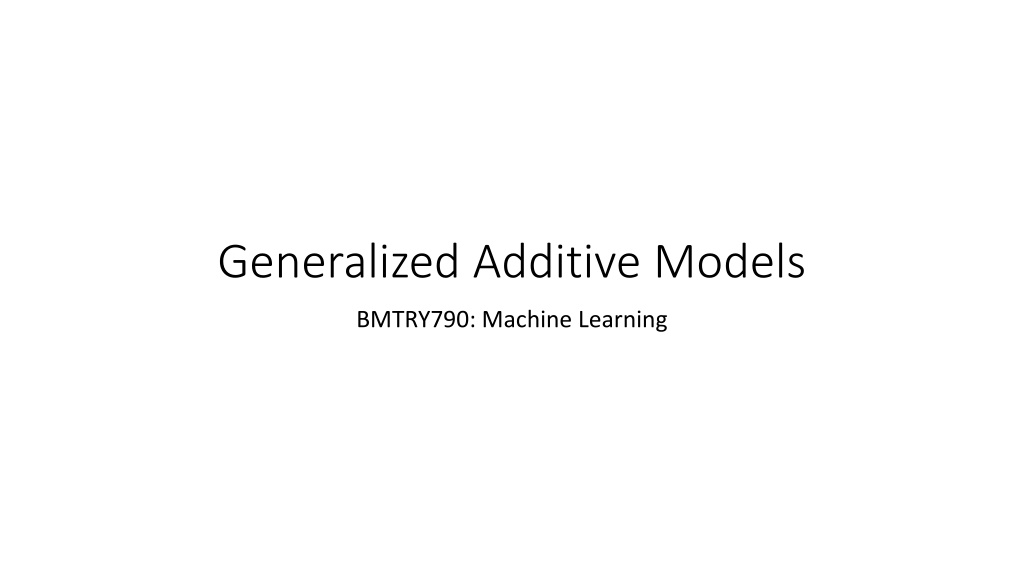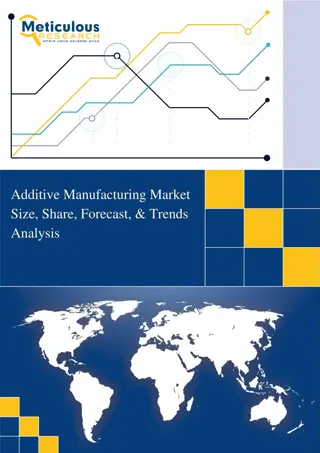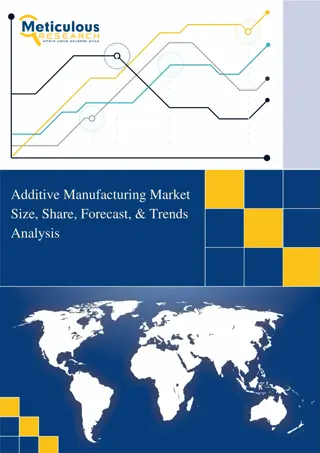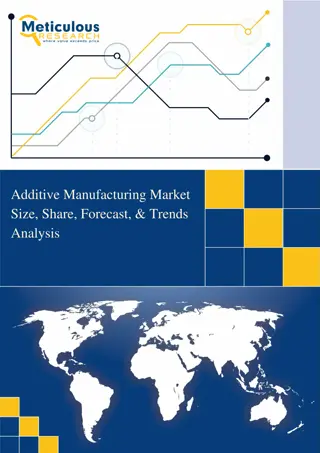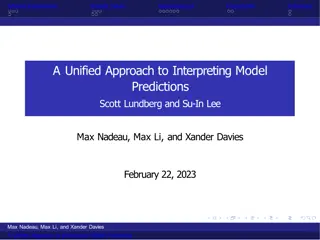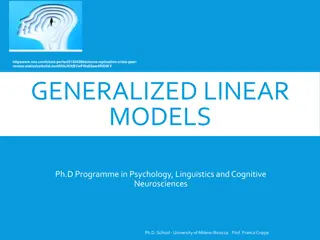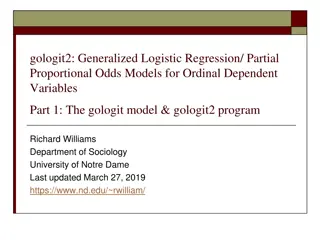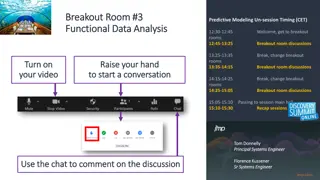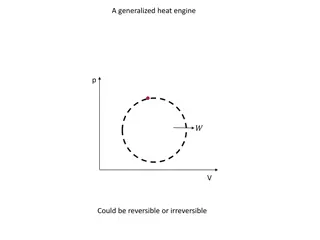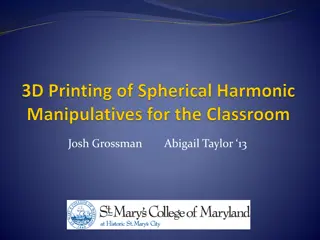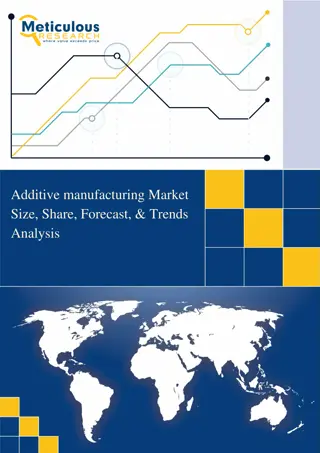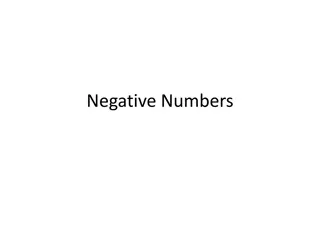Generalized Additive Models
Generalized Additive Models (GAMs) provide a flexible and automatic statistical method for identifying and characterizing nonlinear regression effects. Unlike traditional linear models, GAMs can capture non-linear relationships between predictors and outcomes using unspecified smooth functions. By fitting each function using scatterplot smoothers, GAMs offer a more comprehensive approach to analyzing data and making predictions.
Download Presentation

Please find below an Image/Link to download the presentation.
The content on the website is provided AS IS for your information and personal use only. It may not be sold, licensed, or shared on other websites without obtaining consent from the author.If you encounter any issues during the download, it is possible that the publisher has removed the file from their server.
You are allowed to download the files provided on this website for personal or commercial use, subject to the condition that they are used lawfully. All files are the property of their respective owners.
The content on the website is provided AS IS for your information and personal use only. It may not be sold, licensed, or shared on other websites without obtaining consent from the author.
E N D
Presentation Transcript
Generalized Additive Models BMTRY790: Machine Learning
Generalized Additive Models (GAMs) Regression models are usefulin many data analyses Provide prediction and classification rules As data analytic tools for understanding the importance of different inputs. Although attractively simple, the traditional linear model often fails: As we ve noted, in real life, effects are often not linear. We ve already talked about splines which use pre-defined basis functions Generalized Additive Models (GAMs) are a more automatic flexible statistical method that may be used to identify and characterize nonlinear regression effects.
Format of GAMs In the regression setting, a generalized additive model has the form E(Y|X1,X2,...,Xp) = +f1(X1) +f2(X2) +... +fp(Xp) Here X1, X2, . . . , Xpare pinput features/predictors and y is a continuous outcome of interest. The fj s are unspecified smooth (nonparametric) functions. So how are GAMs different?
Format of GAMs If each function was modeled using an expansion of basis functions, we could fit this model using least squares GAMs fit each function within our model expression using a scatterplot smoother (like a spline or kernel smoother) But simultaneously applied to estimate all p functions
Format of GAMs for Link Function We can extend this to the generalized linear model case For example,logistic regression relates the mean of the binary response m(X) =P(Y=1|X =x) to the predictors through a link functions ( ( ) ) = = 1 0 P Y P Y ( ) ( ) X m ( ) = = = + + + log log log ... it it Y X X 0 1 1 p p The additive logistic regression model replaces each linear term by a more general functional form: ( ) ( ) 0 P Y = = 1 P Y ( ) ( ) ( ) = = + + + log log ... it Y f X f X 0 1 1 p p
Format of GAMs for Link Function As in the linear regression case, the fj s are unspecified smooth functions for each predictors. The use of these nonparametric functions, fj, allows for model flexibility in estimating the probability of Y = 1. However, the additivity of the model allows us to interpret the impact of the predictors on Y
General Form of a GAM This model form can easily be extended to alternative link functions for other types of links ( ) ( ) 0 1 1 g X f X m = + + ( ) ( ) + ... f X p p Examples include g (m) = m is the identity link for linear and additive models for continuousresponse g (m) = logit(m) or g(m) = probit(m) for modeling binomial probabilities Probitfunction is the inverse Gaussian CDF: ( ) ( ) probit m = m 1 g (m) = log(m) for log-linear or log-additive models for Poisson count data
Additive Models with Linear and Non-Linear Effects Can consider bothlinear and other parametric forms with the nonlinear terms Note this is necessary for qualitative input variables(e.g. sex) Nonlinear terms not restricted to main effects Can have nonlinear components in two or more variables Separate curves in an input Xjfor different levels of a factor variable Xk For example: Semiparametricmodel: Nonparametric in 2 inputs: ( ) ( ) m ( ) ( ) f Z m = = + + = + T g X I V k k ( ) f X ( ) , g g Z W
Fitting Additive Models If model each function fjas a natural spline, the resulting model can be fit using a regression approach The basic form of this additive model is: ( ) p = + + Y f X j j = 1 j
Fitting Additive Models Now, given data with observations (xi, yi) we could treat this like we did a smoothing spline and use a penalize fitting approach ( ) p N ( ) ( ) ( ) t 2 2 p = + l '' , , ,..., PRSS f f f y f X f dt 1 2 p i j j j j j j = 1 j = = 1 1 i j Where ljare tuning parameters Minimizer is additive cubic spline model where each fjis a cubic spline in input Xj Knots are each unique value of xij
Fitting Additive Models Without restrictions there isn t a unique solution So what can we do? The constant is not identifiable because we can add/subtract any constants from each fjand adjust accordingly. So consider the restriction ( ) x ( ) N = = 0 f ave y j ij i = 1 i i.e. functions average to 0 over the data If the matrix of input values also has full column rank, then PRSSis strictly convex and the minimizer is unique
Backfitting Algorithm A simple iterative procedure exists for finding the solution. = ( ) jf N Set and initialize Cycle through j = 1, 2, , p to estimate and update = ave y y 0, , 1 N i j i i = 1 i N ( ) f f S y x j j i k ik k j = 1 i 1 N N ( ) f x f f j j i ij = 1 i Repeat this process for each fjuntil fjstabilizes
Fitting Additive Models This backfittingalgorithm is also referred to as is the grouped cyclic coordinate descent algorithm Alternative smoothing operators other than smoothing splines can be used For example Sjcan be: Other regression smoothers Linear regression operators Surface smoothers, higher-order interactions, etc. For generalized additive models (e.g. logistic additive model), we can use the penalized log-likelihood as our criterion
Local Regression (loess) Loess is an alternative smoother (rather than splines) In the class of neared neighbor algorithms Simplest type is a running mean smoother Nonparametric regression technique Loess = locally estimated scatterplot smoothing Capture general patterns with minimal assumptions while reducing noise Line through the moving central tendency of X vs. Y
Local Regression (loess) Basic format Select a smoothness based on a span parameter (proportion of data included in sliding mean average, aka neighbors) Calculate where h is the width of the neighborhood Construct weights based on ( ) = d x x h i i ( ) 3 3 i 1 d x inside the neighborhood = i w i 0 otherwise Fit a weighted regression with using the weights calculated above
Fitting GAMs GAMs can be fit in both SAS and R SAS can fit these models using: proc gam In R there are two libraries for fitting GAMS gam Uses backfitting Matches fitting algorithm in SAS mgcv library Different approach to picking the amount of smoothness (quadratic penalized maximum likelihood approach) Only one that will handle thin-plate splines
Ozone Example Example: Ozone Concentrations over time Data include 111 observations for an environmental study Measured six variables over 111 (nearly) consecutive days. Ozone: surface concentration of ozone(parts per billion) Solar.R: level of solar radiation (lang) Wind: Wind speed (mph) Temp: Air temperature (oF) Month: Calendar month Day: Day of the month
SAS: proc gam The general form of the proc gam is PROC GAM < option > ; CLASS variables ; MODEL dependent = < PARAM(effects) > smoothing effects < /options > ; SCORE data=SAS-data-set out=SAS-data-set ; OUTPUT <out=SAS-data-set> keyword < ...keyword> ; BY variables ; ID variables ; FREQ variable ;
SAS: proc gam Most options are familiar. The two important ones are: MODEL dependent = < PARAM(effects) > smoothing effects </options >: Model terms can be added by the following possibilities PARAM(x) : Adds a linear term in x to the model SPLINE(x): Fits smoothing spline with the variable x. Degree of smoothness can be controlled by DF (default = 4) LOESS(x): Fits local regression with variable x. Degree of smoothness can be controlled by DF (default = 4) SPLINE2(x,y): Fits bivariate thin-plate smoothing spline in x and y. Degree of smoothness can be controlled by DF (default = 4). At least one model term must be defined, though any combination of these is fine.
SAS: proc gam The two important options for the MODEL statement are: METHOD = GCV: Chooses smoothing parameters by generalized cross- validation. If DF is set for a variable, that choice overrides the GCV. DIST = : Specifies the conditional distribution of the response variable. The choices are GAUSSIAN (default) BINARY BINOMIAL GAMMA IGAUSSIAN POISSON. As mentioned before, only the canonical link can be used in each case..
Single Spline in SAS ods html; ods graphics on; proc gam data = air; model Ozone = spline(Temp); output out = air_spline predicted residual; run; ods graphics off; ods html close;
Multiple Splines in SAS ods html; ods graphics on; proc gam data = air; model Ozone = spline(Solar_R) spline(Wind) spline(Temp); output out = air_spline predicted residual; run; ods graphics off; ods html close;
Splines + Linear Parameter in SAS ods html; ods graphics on; proc gam data = air; model Ozone = spline(Solar_R) spline(Wind) spline(Temp) param(time); output out = air_spline predicted residual; run; ods graphics off; ods html close;
Loess in SAS ods html; ods graphics on; proc gam data = air; model Ozone = loess(Temp); output out = air_loess predicted residual; run; ods graphics off; ods html close;
GAM Models in R ### Fitting GAMs using gam library library(gam) air<-read.csv("H:\\public_html\\BMTRY790_Spring2023\\Datasets\\Air.csv") head(air) Ozone Solar.R Wind Temp Month Day time 1 41 190 7.4 67 5 1 1 2 36 118 8.0 72 5 2 2 3 12 149 12.6 74 5 3 3 4 18 313 11.5 62 5 4 4 5 NA NA 14.3 56 5 5 5 6 28 NA 14.9 66 5 6 6
GAM Models in R ### Fitting GAMs using gam library ozmod<-gam(log(Ozone)~s(Solar.R)+s(Wind)+s(Temp), family=gaussian(link=identity),data=air) summary(ozmod) Call: gam(formula = log(Ozone) ~ s(Solar.R) + s(Wind) + s(Temp), family = gaussian(link = identity), data = air) Deviance Residuals: Min 1Q Median 3Q Max -1.84583 -0.24538 -0.04403 0.31419 0.99890 (Dispersion Parameter for gaussian family taken to be 0.2235) Null Deviance: 82.47 on 110 degrees of freedom Residual Deviance: 21.9077 on 98.0001 degrees of freedom AIC: 162.8854 42 observations deleted due to missingness Number of Local Scoring Iterations: 2
GAM Models in R ### Fitting GAMs using gam library ozmod2<-gam(log(Ozone)~s(Solar.R)+s(Wind)+s(Temp), family=gaussian(link=identity),data=air) summary(ozmod2) Anova for Parametric Effects Df Sum Sq Mean Sq s(Solar.R) 1 16.041 16.0408 71.756 2.484e-13 *** s(Wind) 1 17.208 17.2083 76.978 5.521e-14 *** s(Temp) 1 12.723 12.7227 56.913 2.351e-11 *** Residuals 98 21.908 0.2235 --- Signif. codes: 0 *** 0.001 ** 0.01 * 0.05 . 0.1 1 F value Pr(>F) Anova for Nonparametric Effects Npar Df (Intercept) s(Solar.R) 3 2.8465 0.04151 * s(Wind) 3 3.4736 0.01897 * s(Temp) 3 2.9358 0.03713 * --- Signif. codes: 0 *** 0.001 ** 0.01 * 0.05 . 0.1 1 Npar F Pr(F)
GAM Models in R ### Fitting GAMs using gam library WITH LINEAR EFFECTS!!! ozmod2a<-gam(log(Ozone)~Solar.R+Wind+Temp+s(Solar.R)+s(Wind)+s(Temp), family=gaussian(link=identity),data=air) summary(ozmoda) Anova for Parametric Effects Df Sum Sq Mean Sq F value Pr(>F) Solar.R 1 16.041 16.0408 71.756 2.484e-13 *** Wind 1 17.208 17.2083 76.978 5.521e-14 *** Temp 1 12.723 12.7227 56.913 2.351e-11 *** Residuals 98 21.7862 0.2246 --- Anova for Nonparametric Effects Npar Df Npar F Pr(F) (Intercept) Solar.R Wind Temp s(Solar.R) 3 2.8465 0.04151 * s(Wind) 3 3.4736 0.01897 * s(Temp) 3 2.9358 0.03713 * --- Signif. codes: 0 *** 0.001 ** 0.01 * 0.05 . 0.1 1
GAM Models in R plot(ozmod2, se=T)
GAM Models in R plot(ozmod2a, se=T)
GAM Models in R (using mcgv) ### Fitting GAMs using mcgv library ozmod2<-gam(log(Ozone)~s(Solar.R)+s(Wind)+s(Temp), family=gaussian(link=identity),data=air) summary(ozmod2) Formula: log(Ozone) ~ s(Solar.R) + s(Wind) + s(Temp) Parametric coefficients: Estimate Std. Error t value Pr(>|t|) (Intercept) 3.41593 0.04486 76.14 <2e-16 *** --- Signif. codes: 0 *** 0.001 ** 0.01 * 0.05 . 0.1 1 Approximate significance of smooth terms: edf s(Solar.R) 2.240 s(Wind) 2.351 s(Temp) 4.494 --- Signif. codes: 0 *** 0.001 ** 0.01 * 0.05 . 0.1 1 Ref.df F 2.818 2.986 5.532 p-value 3.80e-05 *** 0.000513 *** 4.25e-09 *** 9.129 6.372 10.890 R-sq.(adj) = 0.702 Deviance explained = 72.7% GCV = 0.24574 Scale est. = 0.22341 n = 111
Model Checking using mcgv gam.check(ozmod2)
Lupus Nephritis Example: Treatment response in patients with treatment response Data include 280 observations examining treatment response at 1 year in patient with lupus nephritis Data includes Demographics: Treatment response: Clinical Markers: Urine markers: age, race Yes/No c4c, dsDNA, EGFR, UrPrCr IL2ra, IL6, IL8, IL12
Lupus Nephritis ### Fitting GAM model with a binary outcome using gam library ln<-read.csv("H:\\public_html\\BMTRY790_Spring2023\\Datasets\\LupusNephritis.csv") head(ln) race age urprcr dsdna c4c egfr il2ra il6 il8 il12 CR90 1 1 21.6 7.390 1 34.7 115.816 84.6 15.7 105.3 0.0 0 2 1 21.6 5.583 1 16.7 51.568 597.5 4.5 23.2 285.8 0 3 0 31.6 5.530 1 1.6 20.034 275.2 22.0 29.0 38.9 0 4 0 31.6 2.161 1 9.7 6.650 279.3 72.2 1691.9 764.4 0 5 1 37.6 2.340 1 5.1 120.722 2313.2 4.7 108.5 949.6 0 6 1 37.6 0.249 0 22.1 102.931 496.3 1.7 26.4 1010.0 0
Lupus Nephritis (using gam) ### Fitting GAM model with a binary outcome using gam library lnmod<-gam(CR90 ~ race + s(urprcr) + s(egfr) + s(il2ra), family = binomial(link=logit), data=ln, trace=TRUE) GAM s.wam loop 1: deviance = 263.3679 GAM s.wam loop 2: deviance = 257.5799 GAM s.wam loop 3: deviance = 256.0531 GAM s.wam loop 4: deviance = 255.5129 GAM s.wam loop 5: deviance = 255.3848 GAM s.wam loop 6: deviance = 255.3683 GAM s.wam loop 7: deviance = 255.3668 GAM s.wam loop 8: deviance = 255.3666 GAM s.wam loop 9: deviance = 255.3666
Lupus Nephritis (using gam) ### Fitting GAM model with a binary outcome using gam library summary(lnmod) Call: gam(formula = CR90 ~ race + s(urprcr) + s(egfr) + s(il2ra), family = binomial(link = logit), data = ln, trace = TRUE) Deviance Residuals: Min 1Q Median 3Q Max -1.7493 -0.7121 -0.5046 0.5204 2.8217 (Dispersion Parameter for binomial family taken to be 1) Null Deviance: 323.3956 on 279 degrees of freedom Residual Deviance: 255.3666 on 266.0001 degrees of freedom AIC: 283.3664 Number of Local Scoring Iterations: 9
Lupus Nephritis (using gam) ### Fitting GAM model with a binary outcome using gam library summary(lnmod) Anova for Parametric Effects Df Sum Sq Mean Sq F value Pr(>F) race 1 0.128 0.1277 0.1214 0.727771 s(urprcr) 1 9.746 9.7463 9.2637 0.002572 ** s(egfr) 1 6.236 6.2364 5.9276 0.015563 * s(il2ra) 1 10.286 10.2861 9.7767 0.001963 ** Residuals 266 279.858 1.0521 Anova for Nonparametric Effects Npar Df Npar Chisq P(Chi) race s(urprcr) 3 6.3233 0.096907 . s(egfr) 3 12.2630 0.006535 ** s(il2ra) 3 7.8942 0.048240 * Signif. codes: 0 *** 0.001 ** 0.01 * 0.05 . 0.1 1
GAM Models in R plot(lnmod, se=T)
Lupus Nephritis (using mcgv) ### Fitting GAM model with a binary outcome using mcgv library lnmod<-gam(CR90 ~ race + s(urprcr) + s(egfr) + s(il2ra), family = binomial(link=logit), data=ln, trace=TRUE) summary(lnmod) Family: binomial Link function: logit Formula: CR90 ~ race + s(urprcr) + s(egfr) + s(il2ra) Parametric coefficients: Estimate Std. Error z value Pr(>|z|) (Intercept) -1.34589 0.27744 -4.851 1.23e-06 *** race 0.04299 0.31947 0.135 0.893 --- Signif. codes: 0 *** 0.001 ** 0.01 * 0.05 . 0.1 1
Lupus Nephritis (using mcgv) ### Fitting GAM model with a binary outcome using mcgv library lnmod<-gam(CR90 ~ race + s(urprcr) + s(egfr) + s(il2ra), family = binomial(link=logit), data=ln, trace=TRUE) summary(lnmod) Approximate significance of smooth terms: edf Ref.df Chi.sq p-value s(urprcr) 1.842 2.309 13.54 0.00212 ** s(egfr) 3.868 4.833 12.93 0.01951 * s(il2ra) 3.016 3.851 13.82 0.00565 ** --- Signif. codes: 0 *** 0.001 ** 0.01 * 0.05 . 0.1 1 R-sq.(adj) = 0.195 Deviance explained = 19.4% UBRE = 0.0075104 Scale est. = 1 n = 280 Note, UBRE stands for unbiased risk estimator and is used like GCV (similar formula)
Lupus Nephritis (using mcgv) par(mfrow=c(1,3), pty="s") plot(lnmod, se=T)
Lupus Nephritis (using mcgv) The mcgv package has some additional features that make it a little nicer than gam Specifically, it will apply an additional penalty parameter to conduct variable selection lnmod2<-gam(CR90 ~ race + s(urprcr) + s(egfr) + s(il2ra) + s(il6) + s(il8) + s(il12), family = binomial(link=logit), data=ln, trace=TRUE) lnmod3<-gam(CR90 ~ race + s(urprcr) + s(egfr) + s(il2ra) + s(il6) + s(il8) + s(il12), family = binomial(link=logit), select=T, data=ln, trace=TRUE)
Lupus Nephritis (using mcgv) summary(lnmod2) summary(lnmod3) Parametric coefficients: Parametric coefficients: Estimate Std. Error z value Pr(>|z|) Estimate Std. Error z value Pr(>|z|) (Intercept) -1.3231 0.3239 -4.084 4.42e-05 *** (Intercept) -1.3704 0.3168 -4.326 1.52e-05 *** race -0.2312 0.3377 -0.685 0.493 race -0.1707 0.3304 -0.517 0.605 Approximate significance of smooth terms: Approximate significance of smooth terms: edf Ref.df Chi.sq p-value edf Ref.df Chi.sq p-value s(urprcr) 1.767 2.205 12.858 0.00245 ** s(urprcr) 1.922e+00 9 15.270 0.000132 *** s(egfr) 3.874 4.833 12.305 0.02525 * s(egfr) 3.011e+00 9 13.454 0.001529 ** s(il2ra) 2.711 3.486 11.707 0.01031 * s(il2ra) 3.070e+00 9 12.892 0.001895 ** s(il6) 1.000 1.001 0.823 0.36472 s(il6) 3.956e-06 9 0.000 0.590378 s(il8) 2.586 3.279 4.419 0.25455 s(il8) 3.214e+00 9 6.595 0.077541 . s(il12) 2.502 3.154 4.681 0.21274 s(il12) 3.059e-01 9 0.438 0.215320 R-sq.(adj) = 0.217 Deviance explained = 23.5% R-sq.(adj) = 0.214 Deviance explained = 22.7% UBRE = 0.00046012 Scale est. = 1 n = 280 UBRE = -0.010709 Scale est. = 1 n = 280
Lupus Nephritis (using mcgv) In the mcgv package, the default basis dimensions used for smooth terms are somewhat arbitrary. Thus these should be checked that they are not too small. However, there is a function to check this.
Lupus Nephritis (using mcgv) ### Checking choice of smoothness parameters lnmod2<-gam(CR90 ~ race + s(urprcr) + s(egfr) + s(il2ra) + s(il6) + s(il8) + s(il12), family = binomial(link=logit), data=ln, trace=TRUE) gam.check(lnmod2) Method: UBRE Optimizer: outer newton Model rank = 56 / 56 Basis dimension (k) checking results. Low p-value (k-index<1) may indicate that k is too low, especially if edf is close to k'. k' edf k-index p-value s(urprcr) 9.000 1.767 1.066 0.92 s(egfr) 9.000 3.874 0.923 0.18 s(il2ra) 9.000 2.711 0.904 0.07 s(il6) 9.000 1.000 0.955 0.26 s(il8) 9.000 2.586 1.010 0.63 s(il12) 9.000 2.502 0.837 0.00
Lupus Nephritis (using mcgv) ### Package authors suggest that if one or more terms appears to have k too small, then try doubling k for that parameter ### Checking choice of smoothness parameters lnmod4<-gam(CR90 ~ race + s(urprcr) + s(egfr) + s(il2ra, k=20) + s(il6) + s(il8) + s(il12, k=20), family = binomial(link=logit), data=ln, trace=TRUE) gam.check(lnmod4) Method: UBRE Optimizer: outer newton Model rank = 56 / 56 Basis dimension (k) checking results. Low p-value (k-index<1) may indicate that k is too low, especially if edf is close to k'. k' edf k-index p-value s(urprcr) 9.000 1.77 1.066 0.905 s(egfr) 9.000 3.87 0.923 0.155 s(il2ra) 19.000 2.94 0.904 0.085 s(il6) 9.000 1.00 0.955 0.300 s(il8) 9.000 2.62 1.010 0.565 s(il12) 19.000 2.52 0.837 0.000
Training a GAM using caret The caret package has the ability to train gam models using either the gam or mcgv packages To use gam, specify the following methods gamLoess loess smoothers, span and df gamSpline spline smoother, df To use mcgv, specify the following methods bam spline smoothers, select and method gam spline smoothers, select and method
Training a GAM using caret ### Training a model using the caret package with mcgv trgam<-train(as.factor(CR90) ~ race + urprcr + egfr + il2ra + il6 + il8 + il12, family = binomial(link=logit), data=ln, method="gam", trControl=trainControl(method="cv", number=10), tuneGrid=expand.grid(select=c("FALSE","TRUE"), method=c("GCV.Cp","GCV.Cp"))) trgam Generalized Additive Model using Splines 280 samples 7 predictor 2 classes: '0', '1' No pre-processing Resampling: Cross-Validated (10 fold) Summary of sample sizes: 253, 251, 252, 253, 251, 252, ... Resampling results across tuning parameters: select Accuracy Kappa FALSE 0.7541553 0.2452008 TRUE 0.7541553 0.2452008
